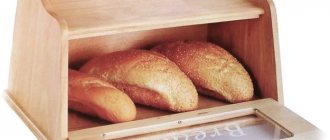Options for storing lids in the kitchen
A convenient option depends on many factors: the shape and size of kitchen equipment, the availability of free space on surfaces and inside cabinets, the dimensions of the kitchen itself, and the style of the interior.
It is advisable to initially choose lids with flat handles that can be stacked like a nesting doll. But even if buying new kitchen equipment is not part of your plans, you can always find the optimal solution.
There are special stands on sale on which you can place a lid and a spoon during cooking. This is convenient during cooking, but such a stand is not enough to store all the dishes. Another variety is a vertical folding structure for storing lids, cutting boards and small pans. They are very convenient to use if the size of the work surface in the kitchen allows.
In small kitchens, take advantage of wall storage ideas - a variety of devices are sold both in hardware departments and in online stores. A separate advantage of such racks is that their height is determined by the buyer.
Many housewives do not like it when kitchen utensils are in plain sight, and not every interior allows such placement. In this case, pay attention to options for storing lids inside kitchen furniture. For example, hanging on cabinet doors or placing in special retractable containers. When making a custom kitchen, make sure that the drawer for pots and pans has a special narrow compartment for lids.
Important! Please note that the width of such a box must be at least 60 cm.
If space in the kitchen allows, order a special pull-out shelf with a height of 5 to 15 cm, depending on the size of the lids. It is convenient to place it in a floor cabinet directly under the tabletop.
Another option for hidden storage is to use stands designed for tabletop storage on cabinet shelves. The only inconvenience of this method is that not every kitchen has enough free space in the cabinets for such an implementation.
Furniture manufacturers offer a wide range of special plastic or metal designs for drawers - you can store pans and lids in them. Despite all their convenience, they have a couple of drawbacks: they require additional space and are quite expensive.
Thrifty housewives can use many ideas on how to make the necessary devices with their own hands. For these purposes, plastic self-adhesive hooks, wooden crossbars, copper wire are used - it all depends only on imagination and budget.
Features of storing lids from pots and pans
One of the most convenient ways of placement is on the inside of the cabinet door.
In any kitchen, space optimization is important; in a small kitchen, this is doubly necessary. There are enough ways to solve the problem; you just need to find your own, the most optimal one.
It’s good if you are just planning to buy and equip a kitchen. In this case, you can immediately determine the storage location. And if the kitchen furniture has been installed a long time ago, and space for small items has not yet been allocated, then you will have to take care of this problem.
It’s convenient when all the dishes are conveniently sorted into categories. This is the main rule that will allow you to maintain order in the kitchen. As a rule, sorting involves selecting individual places and shelves:
- for pots and pans;
- under baking dishes;
- under the covers.
Once the location is determined, you can think about different devices that will allow you to place the dishes comfortably, in accordance with the size of the kitchen, drawers and cabinets.
It is also important to distribute dishes according to frequency of use. Things that the housewife does not use often (cauldrons, pressure cookers, duck pots) can be removed further by selecting a place where these items will not interfere.
Life hacks for the kitchen: how to store lids inside the cabinet
Most housewives prefer closed storage of lids - this creates visual order and does not clutter up the kitchen space. A separate advantage of hidden storage is that kitchen utensils inside the cabinets are protected from dust, which means the housewife saves time spent on cleaning. There are many indoor storage solutions that you can do yourself.
Railings
Conventional roof rails are very popular for storage inside cabinets. They can be attached to the side wall or the inside of the door. Before purchasing, measure the length of the surface onto which the railing will subsequently be screwed. Installation is not a problem - usually all the necessary parts are sold complete with the railing or they can be purchased separately.
String
Another win-win option is to measure the diameter of the lids and attach with two self-tapping screws inside the cabinet several strings or pieces of copper wire of suitable length, folded several times. The lid threaded through a similar loop will be attached to the door or wall of the cabinet.
Important! The string or wire should sag slightly, so the weight will be optimally distributed along the entire length, which will ensure reliable fastening.
Rubber band
This storage method is similar to the previous one, but has one advantage: unlike a string, a rubber band, when stretched, will hold lids of different diameters. This is a cheap method with simple installation.
Important! When installing the railing, strings or rubber band, be sure to ensure that the protruding lid handle does not prevent the door from closing. Adjust the height of the fasteners so that the handle fits inside the cabinet and is not flush with the interior shelf.
LiveInternetLiveInternet
Storing lids from pots and pans is an important point in a small kitchen.
Storing them together with dishes is problematic due to cluttering of space, and it is impossible to allocate a special place due to their non-compact shape.
Where do you store your pot and pan lids? Until recently, I kept the pots in the closet, stacking them one inside the other, and placing the lids somewhere nearby.
Storing lids on top of pots, as most inexperienced housewives do, means cluttering the entire kitchen with containers. And since in most apartments its area is very limited, this method can be immediately rejected.
In most cases, another storage method is not suitable: in a stack or “matryoshka”. If such an organization is quite justified for pots, then the protruding handles of the lids will create a very unstable structure that will frighten you with a rumble every time you want to open the drawer.
I must say, this irritated me terribly, because finding an item of the right size was sometimes very difficult. And then I decided to organize the storage of lids “scientifically”, using household appliances.
I have collected, in my opinion, the most interesting ways to store lids. And all you have to do is choose the best option - depending on the size of the kitchen and the volume of cabinets.
Let's see what options are there?
Special drawers In a fairly spacious kitchen, where at least 1 whole cabinet, or even more, is allocated for storing pots and pans, you can provide a pull-out shelf (5 to 15 cm high on the sides), which can be located above or below the place where the pots are stored .
If your kitchen set has a similar design, feel free to load it with lids.
It is recommended to place them in one layer, because otherwise you will not optimize, but on the contrary, you will clutter your workspace.
Storage compartment for lids in a deep drawer If you are making a custom kitchen or are willing to spend money on convenient internal dividers (like Rationel from IKEA), pay attention to the practical organization inside the drawers shown in the photo in this section. A special narrow compartment is separated from one or both sides, in which lids are ideally placed.
It is optimal to use for deep drawers of base cabinets with a width of at least 60 cm, otherwise there will simply be no space left for pots and pans.
Pull-out sections If you are willing to spend money on pull-out metal interior elements of kitchen cabinets, look for those options that have special compartments for lids.
Pots and pans will be stored in the same cabinet, which, of course, is very convenient. Which utensils will be at the top and which at the bottom depends on the manufacturer.
An economical option is an analogue of the Ikea Variera retractable container made of white plastic.
The more solid one looks like a narrow mesh shelf with limiters.
Both options move along guide rails that are attached to the lower inside of the cabinet next to one of the side walls.
Tabletop stands for a couple of lids and other utensils If there are few kitchen utensils and there is enough space on the countertop, you can store the lids in a tabletop stand like this. And along with them - cutting boards, flat dishes and even small frying pans.
We place lids on the shelves of wall-mounted or floor-standing cabinets. This can be called a modification of tabletop storage, but more spacious. You can use tabletop dish drainers or wooden racks for storing plates, or look in stores for special devices for lids of this type. All this equipment is placed inside deep drawers or (more often) on the shelves of cabinets, usually floor-standing.
[/td]
Wall racks for lids If you have nothing against open storage of kitchen items, pay attention to the possibility of wall-mounted space for lids from pots and pans.
These racks are quite economical in price, and the height (how many covers it is designed for) can be chosen according to your own needs.
Now let's talk about the most economical (and original) ways to store lids for pots and pans. If, instead of spending money, you prefer to invest your own skills and resourcefulness, make your own organizing racks.
Rails for storing lids - on the walls and doors of cabinets. The simplest and most budget option. Suitable for storing lids on the wall or the inside of a kitchen cabinet door. Measure the surface area allocated for this purpose, and then simply purchase a suitable rail.
Mounting type and material - any. Screw on using the included (or specially selected) fasteners and enjoy the order in your pot lids.
If you use rails to organize a large-scale storage system on a free wall, simply place lids there: you can hang a variety of kitchen utensils on the hooks, and store lids behind the rails.
Storage with hanging shelves with dividers:
The method shown in the photo below is also easy to implement with the hands of a home craftsman. You will need a perforated board of the required size + hooks for it. Pans can be hung on hooks secured in the usual way. And fix the lids with hooks placed at an angle.
Now let's move on to closed storage, which will certainly be appreciated by housewives who are confident that only cabinets with doors can provide the necessary order.
There are many ways here. The main advantage of any of them is hidden storage. How to choose? Focus on 2 parameters: the size of your closet and the budget allocated for these convenient devices.
Cabinet door covers:
We are used to using only shelves in closets. What about the doors? On the inside, you can attach additional hooks and baskets to them so that important little things are always at hand, and you don’t have to go deep into the cabinet to get them. In the photo I offer only some of the options for using this useful space, it’s all up to your imagination!
In my opinion, it is best to allocate a place for the lids just on the inside of the doors. Here are some ideas for attachments: hooks, towel racks or other fixtures - the choice is yours, as long as they are as easily accessible as possible.
It is most convenient to use devices specifically designed for swing doors of floor-standing cabinets or the most compact of wall cabinets. IKEA has a large selection of such devices.
A few more original ways for thrifty housewives:
Plastic hooks with reverse adhesive layer. This is the mounting option I used :)
The container for one lid is made using 2 hooks attached in accordance with its diameter.
You will need 2 pieces for each cover, they will support it from the side and bottom.
Mark and glue. That's it!
Let's look:
Wooden bars for towels.
And the simplest option. Copper wire twisted in several layers + wood screws.
All these options are suitable for storing lids on the door and on the cabinet wall.
The inner side of the doors from the lower modules can also be used to store household chemicals or small items necessary for cleaning: gloves, rags and sponges, etc. The boxes that you attach from the inside, in this case, can be larger and more spacious.
Adviсe:
- When you fix additional hooks or doors, make sure that when closed they and what will be stored there do not touch the shelves, otherwise the door simply will not be able to close.
- The weight of items must be within reason!
And lastly... Kitchen stands for one lid and a chef's spoon: Western housewives have long appreciated this wonderful device. When preparing food, it allows you not to think about where to put the lid removed from the pan and the spoon used to stir the dish.
Sometimes such a stand for a lid and spoon is also found in dishware stores. If you want more choice, check out online stores.
Based on materials from www.design-remont.info, domovityi.ru
To the hostesses:
15 kitchen tricks that will make your life easier
Optimizing space in a small kitchen
30 household problems that Coca-Cola will quickly and effectively eliminate
How to make a wall shelf with your own hands
The easiest way to create a storage area for lids is to use plastic hooks with an adhesive surface. They are quite suitable for light objects. Having measured the lid, it is necessary to place two or three, for greater reliability, hooks in the lower part of the circle so that it is located in them, as in grooves.
However, a shelf for storing lids and pans made from perforated boards, which can be purchased at any hardware store, looks more aesthetically pleasing and colorful. Having attached such a board to the wall, fasten the hooks in its holes at the required distance from each other. And hang any suitable dishes on them.
Types of stands
Depending on the characteristics of the room and the number of items, choose methods for external or internal storage of pot lids in the kitchen. Various options for holders, fasteners, and dividers are used. When choosing, you should take into account the overall style of the interior. External designs involve placing accessories on the surface of the countertop. Pot lid stands with organized contents allow you to see the entire collection - from the largest to the smallest items. The method is convenient, practical, but only acceptable in spacious kitchens.
A type of external stands are models for combined storage of lids with cutlery. The design of the organizers includes:
- main compartment for holding one or more covers;
- additional cells for spoons, forks, knives;
- hooks for hanging cups.
Such models are convenient for temporary placement of utensils necessary during the cooking process, with frequent stirring, adding spices, and checking the readiness of the dish. The stands require proper care, otherwise evaporation deposits and crumbs will accumulate. Washing the holders with detergent allows you to maintain an attractive appearance and store clean dishes until the next time you cook. Thanks to the large size of the table stands, you can place pans, trays, large dishes, and cutting boards on them.
A practical solution is to store the lids internally in cabinets. The method is suitable for thrifty housewives who strive to maximize the cleanliness of their dishes and prefer free space on the surface of the countertop. There are different options for placing covers:
- on an additional stand attached to the inside of the cabinet door;
- in containers of pull-out shelves;
- in boxes with dividers for each item, including lids, pans, and other utensils.
Internal stands, dividers, holders for different lids of pots are mounted when creating furniture or built into ready-made cabinets to order. Individual solutions most accurately reflect housewives’ requests for the placement of each element of kitchen utensils. Stands for temporary storage of wet lids are installed above the drain pan in a cabinet near the sink. Periodically you need to drain the liquid and monitor the cleanliness of the structure. Drying racks are convenient for small kitchens where it is not possible to place organizers. Housewives who do not wipe the dishes after washing leave the utensils in them until they dry completely. The device becomes a storage system with periodic replacement of dry dishes with wet ones after washing.
A popular solution to the question of how to store lids is to install rails on the internal and external surfaces of walls and cabinets. The advantages of fastenings include free choice of location and independent production of the device. Typically, holders are placed on the side wall of a kitchen unit, on an outer shelf, installation inside a drawer, or on a cabinet door is allowed. Some models are hung directly from the stove, which simplifies the cooking process. Housewives do not waste time searching for a suitable lid.
The disadvantage of this placement is fatty deposits from evaporation on the dishes. Another disadvantage of the device is the same fastening for storing lids of different diameters and thicknesses. Difficulties arise when placing non-standard elements. When installing roof rails, it is recommended to make several size options, taking into account large and small hands and utensils of different shapes.
Internal
Outdoor
Pull-out sections in the closet
Special pull-out sections, similar to a bottle holder, with an already installed structure for storing pot lids, cutting boards and small frying pans, are very popular when ordering a ready-made kitchen set. However, the use of such sections is convenient only in a large kitchen, and the cost of furniture with non-standard filling is significantly higher than the price of a regular set.
Railings
A simple, budget-friendly and stylish option for open storage is the installation of roof rails. By choosing the right fixation height, you can use them to hold pot lids. The disadvantages are standard - the apron will look slightly untidy and cluttered. In addition, if you have a large number of covers, you may simply not have enough free wall space to accommodate them.
But storing lids on roof rails will not always create the impression of clutter. If you have a stylish set from one series, and there is already a railing system on the wall that allows you to organize cutlery and kitchen utensils, then adding another holding element will be the logical conclusion of the idea of compactness and pragmatism.
We place lids on the shelves of wall-mounted or floor-standing cabinets
Do you need to free up your countertop and increase your work space?
Then transfer ideas for table top lid storage to floor or wall cabinet shelves. Another convenient option is a special wooden box with holes in the bottom. The lids are placed in any order, with special separating cones inserted into the holes. In addition, IKEA and other furniture manufacturers offer a wide range of folding organizers for such utensils.
How to store pots in a cabinet
Firstly, you should not store old pans that you no longer use. We need to get rid of the battered and damaged kitchens from the battlefields. A scratched non-stick coating is of little use, and pieces of peeling Teflon are harmful to health. In the struggle for kitchen space, the principle is simple: less is more.
Secondly, many well-known manufacturers (for example, Tefal, Cristel, Hatamoto) produce pans with removable handles. It is very comfortable! They can be used not only on the stove, but also in the oven, and the removable handles save space.
Third, evaluate the cabinets available in the kitchen. It is convenient to store pans in wall structures like a “matryoshka”: when the large one fits the medium one, and the one fits the small one. In this case, the lids are stored separately. If the height of the cabinet allows, then the larger one can be covered using the “lid inward” method, and then place a smaller saucepan on top, which in turn can also be covered with a lid. This method is called “pyramidal”.
For roll-out cabinets, a convenient option is to store pots immediately with the lid on. Here everything is at hand and you don’t have to look for anything.
They are:
- plastic;
- from synthetic materials;
- from natural fibers.
Pull-out narrow shelves for lids above the tabletop
When creating a kitchen project, take care of your comfort and provide a special narrow drawer directly under the countertop. Its height can be from 5 to 15 cm: in a horizontal position, up to five covers of different sizes can be placed there. When choosing the height, pay special attention to the shape of the handles on the lids - the more they protrude, the higher the drawer should be.
This is interesting:
Pots for cooking jellied meat - how to choose the right one.
Pots with a capsule bottom - what are they?
How to remove burnt carbon deposits from an enamel pan.
Non-standard methods
For those who are not looking for easy ways, there are some interesting and non-standard ideas for storing pots and pans. They are very diverse, which is even amazing. By resorting to some tricks, you can put kitchen utensils in order even in a small kitchen without having to renovate.
Cabinet doors
Very often, space on cabinet doors remains unoccupied simply because it is undervalued. Everyone is accustomed to the rational use of shelves, but the doors remain free. But you can easily place the lids on them on special slats or hooks. You can also place even shallow frying pans and ladles. It is very important to take into account the degree of load so that the doors do not sag.
Lids on the cabinet door.
Ends and external walls of kitchen furniture
Using the same principle, you can adapt an improvised organizer for dishes on the end parts of kitchen furniture and even on the front side. And it is not so important what to attach and lay out pots, pans or lids, the main thing is that it is convenient for them and the owners. And there can be many assistants in this matter: unique slats, roof rails, heated towel rails, hooks, shelves and other devices.
The lid on the end of the furniture.
Internal walls of cabinets
You can conveniently place dishes on the walls inside cabinets so that they do not disturb others and are at hand. You can screw the hooks on, or you can buy them with suction cups. The main thing is to conveniently calculate the space so that both the dishes that are on the shelves and those that will be suspended fit.
Method of storing lids on the inside wall of a cabinet.
Under wall cabinets
Almost all kitchen sets are designed in such a way that they have upper wall cabinets and lower cabinets that stand on the floor. But if the distance between them allows, you can attach shelves to the hanging ones, even those that will accommodate pots. This will combine business with pleasure, and the stylish appearance will not be spoiled, and the dishes will be in order.
Wall cabinet in the kitchen.
Drawers in the plinth
There is kitchen furniture in which special small drawers have already been prepared for lids and pans. But there are no such people, so don’t despair. They can be made from fairly inexpensive materials and placed in a plinth. And if this design is made on wheels, it will be much more convenient.
Plinth for storing lids.
Additional shelving, consoles and carts
If you have space in the kitchen, you can conveniently adapt additional pieces of furniture that can accommodate any utensils. These can be small mobile carts or convenient tabletops. The stores have these devices for every taste and budget.
Rack for lids.
Engage the window
If you really have a hard time with space or really want to experiment, you can place the dishes on the window. There is already room for imagination. They can be placed vertically, horizontally, on shelves, hooks or even on the windowsill itself. The main thing is that the creation of a utensil fixture is pleasing to the eye.
A kitchen with a window is an additional option for storing lids.











